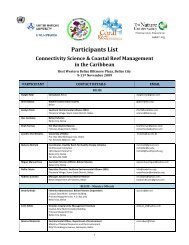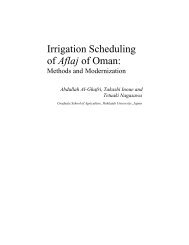The Global Water Crisis: Addressing an Urgent Security - Unu-inweh ...
The Global Water Crisis: Addressing an Urgent Security - Unu-inweh ...
The Global Water Crisis: Addressing an Urgent Security - Unu-inweh ...
Create successful ePaper yourself
Turn your PDF publications into a flip-book with our unique Google optimized e-Paper software.
Introduction<br />
<strong>The</strong> implications of water scarcity on development are clear. At a fundamental level, water scarcity affects our capacity<br />
to grow food. Agriculture uses the largest share of the earth’s freshwater resources, <strong>an</strong>d it is obviously needed to supply<br />
food to all. But agriculture is also critical as a pathway out of poverty for rural producers <strong>an</strong>d as a me<strong>an</strong>s to supply lowcost<br />
food to the urb<strong>an</strong> poor. As water scarcity starts to constrain agricultural output, not only will the total volume of<br />
agricultural products required for food <strong>an</strong>d to feed livestock be affected, but the communities that depend on farming<br />
for livelihoods will also face hardship in securing a living. <strong>The</strong>re have already been two global food crises in the past five<br />
years (in 2007-2008 <strong>an</strong>d again in 2011), with soaring prices that have impacted producers, consumers <strong>an</strong>d cities, especially<br />
the urb<strong>an</strong> poor. <strong>The</strong> long-term impact of unsustainable water use, together with increasing water variability caused by<br />
climate ch<strong>an</strong>ge <strong>an</strong>d m<strong>an</strong>ifested as floods <strong>an</strong>d droughts, me<strong>an</strong>s that hum<strong>an</strong>s’ capacity to continue using agricultural water<br />
the way it has been used in the past simply will not sustain hum<strong>an</strong>ity in the future. <strong>The</strong>re is little doubt that putting water<br />
on the global agenda is critical not just in order to feed 9 billion people in 2050 with less agricultural water th<strong>an</strong> what<br />
is available today, but also to address the critical development challenge of doing this in a safe, sustainable way while<br />
protecting the livelihoods of the vast number of rural poor (Brown, 2011). This paper outlines some of the trends that are<br />
intensifying the competition for agricultural water <strong>an</strong>d presents the challenges of bal<strong>an</strong>cing environmental concerns with<br />
those of hum<strong>an</strong> well-being. Future investments in water need to consider a r<strong>an</strong>ge of options from different perspectives<br />
in order to achieve this bal<strong>an</strong>ce.<br />
1. Underst<strong>an</strong>ding Scarcity<br />
A common knowledge of water scarcity usually entails <strong>an</strong> underst<strong>an</strong>ding of the physical lack of water. <strong>Water</strong>scarce<br />
regions are those areas of the world in which water basins no longer exist, <strong>an</strong>d where rivers no longer<br />
reach the oce<strong>an</strong> because they have dried out from over-exploitation of water resources. <strong>Water</strong>-scarce regions<br />
typically encompass drier <strong>an</strong>d more arid agro-ecological zones, where water may have always been scarce. It has<br />
now been estimated that 1.2 billion people live in areas of physical water scarcity (as shown in Figure 1). But there<br />
is also what has come to be called economic water scarcity. Economically water-scarce regions are those that<br />
still have water resources, but where people c<strong>an</strong>not access them because of a lack of infrastructure (Figure 1).<br />
map 2 Areas of physical <strong>an</strong>d economical water scarcity<br />
Little of no water scarcity<br />
Physical water scarcity<br />
Approaching physical water scarcity<br />
Economic water scarcity<br />
Not estimated<br />
Definitions <strong>an</strong>d indicators<br />
• Little or no water scarcity. Abund<strong>an</strong>t water resources relative to use, with less th<strong>an</strong> 25% of water from rivers withdrawn for hum<strong>an</strong> purposes.<br />
• Physical water scarcity (water resources development is approaching or has exceeded sustainable limits). More th<strong>an</strong> 75% of river flows are withdrawn for agriculture, industry, <strong>an</strong>d domestic<br />
purposes (accounting for recycling of return flows). This definition - relating water availability to water dem<strong>an</strong>d - implies that dry areas are not necessarily water scarce.<br />
• Approaching physical water scarcity. More th<strong>an</strong> 60% of river flows are withdrawn. <strong>The</strong>se basins will experience physical water scarcity in the near future.<br />
• Economic water scarcity (hum<strong>an</strong>, institutional, <strong>an</strong>d fin<strong>an</strong>cial capital limit access to water even though water in nature is available locally to meet hum<strong>an</strong> dem<strong>an</strong>ds). <strong>Water</strong> resources are abund<strong>an</strong>t<br />
relative to water use, with less th<strong>an</strong> 25% of water from rivers withdrawn for hum<strong>an</strong> purposes, but malnutrition exists.<br />
Source: International <strong>Water</strong> M<strong>an</strong>agement Institute <strong>an</strong>alysis done for the Comprehensive Assessment of <strong>Water</strong> M<strong>an</strong>agement in Agriculture using the <strong>Water</strong>sim model; chapter 2.<br />
Figure 1. Areas of physical <strong>an</strong>d economic water scarcity (CA, 2007).<br />
<strong>Water</strong>, Food <strong>an</strong>d the Development Challenge<br />
Part 2<br />
95




